Looking back at first Poush Mela: Maharshi Debendranath’s vision
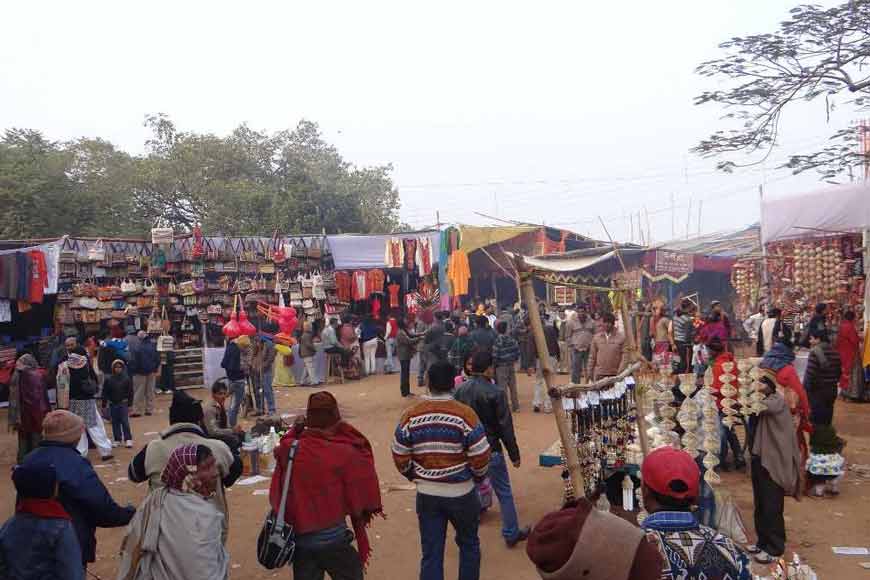
In this 2-part series, GB brings you the inaugural Poush Mela of Santiniketan on 7th Poush 1892
The history of Poush Mela coincides with the ceremonial opening of the Upasana Griha (Prayer Hall) at Santiniketan. In 1888, when the Santiniketan Trust Deed was drafted, provision was made for an annual fair. The opening day celebration of the Brahmo Prayer Hall in Santiniketan was held on 21 December 1891 (7th Poush 1298 according to Bengali calendar). The fair formally started in 1892 in the northern part of the Brahmo Mandir. Over the years, as the footfalls of visitors escalated and the dimension of the fair increased considerably, the venue was shifted to the ground in Purba Pally.
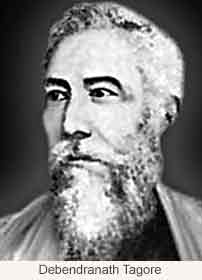 Debendranath envisioned the fair as a platform of interaction between the local rural community and the urban, well-educated aristocrat Brahmos who congregated at Santiniketan on the auspicious day. Local villagers were allowed to showcase and sell their products. The Poush Mela authorities made provisions for their entertainment that included organizing elaborate firework display after the evening prayer session, staging of Jatra Palas (popular open air theatre) and renditions by folk artistes. What started as an unmitigated ceremonial religious meet to deliberate and perhaps propagate Brahmoism on 7th Poush, charted a new course of interacting with rural people and tribal folks living in villages around Santiniketan.
Debendranath envisioned the fair as a platform of interaction between the local rural community and the urban, well-educated aristocrat Brahmos who congregated at Santiniketan on the auspicious day. Local villagers were allowed to showcase and sell their products. The Poush Mela authorities made provisions for their entertainment that included organizing elaborate firework display after the evening prayer session, staging of Jatra Palas (popular open air theatre) and renditions by folk artistes. What started as an unmitigated ceremonial religious meet to deliberate and perhaps propagate Brahmoism on 7th Poush, charted a new course of interacting with rural people and tribal folks living in villages around Santiniketan.
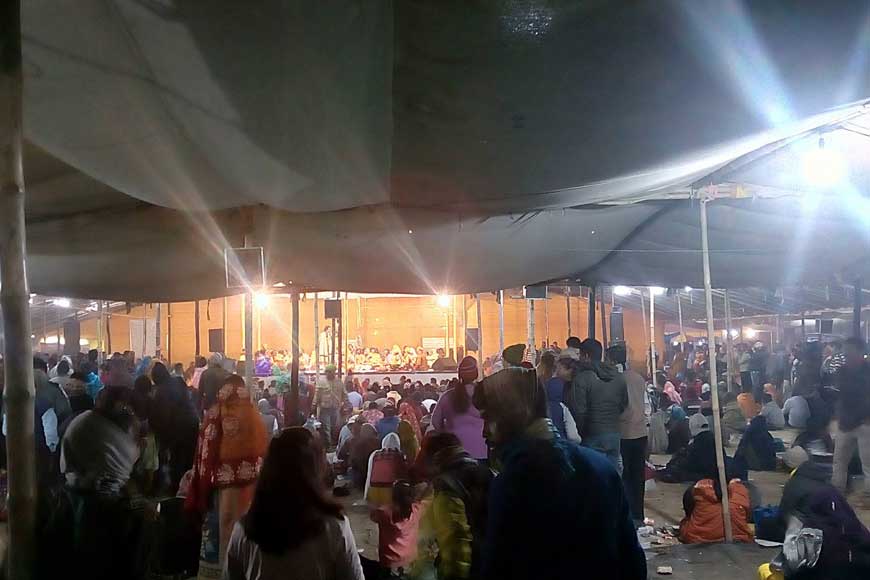
Following the Maharshi’s diktat, the trustee board organized the Poush Mela in 1894. The magnificent Upasana Griha (also known as Kanch Mandir) was built in 1891. On the day of its inauguration, the vast open surroundings of Bhuvandanga echoed with the mellifluous chorus of hymns chanted by Brahmo followers. Prominent members of the Samaj including Dwijendranath Tagore, Shivnath Shastri, Chintamani Chattopadhyay and Umesh Chandra Dutta were present at the venue. They all paid obeisance to the spot under the pair of Chhatim trees where the Maharishi meditated. The learned men delivered speeches, sang sacred songs and exchanged ideas and future plans. Unbeknown to those present, history was being created that day. From 1894 Poush Mela was held in the open ground, on the northern side of the temple.
However, Debendranath himself did not attend the fair. The mood of the Poush Mela in its nascent days was very different. Bells would chime at the crack of dawn and the air would be filled with the harmonious sound of prayers. Later, food would be offered to the poor. Sellers would arrange the wares for customers. Elaborate Firework display was a major attraction for the visitors in the evening after the prayers. An amount of Rs 1732 and 10 annas was sanctioned for the first Poush Mela.
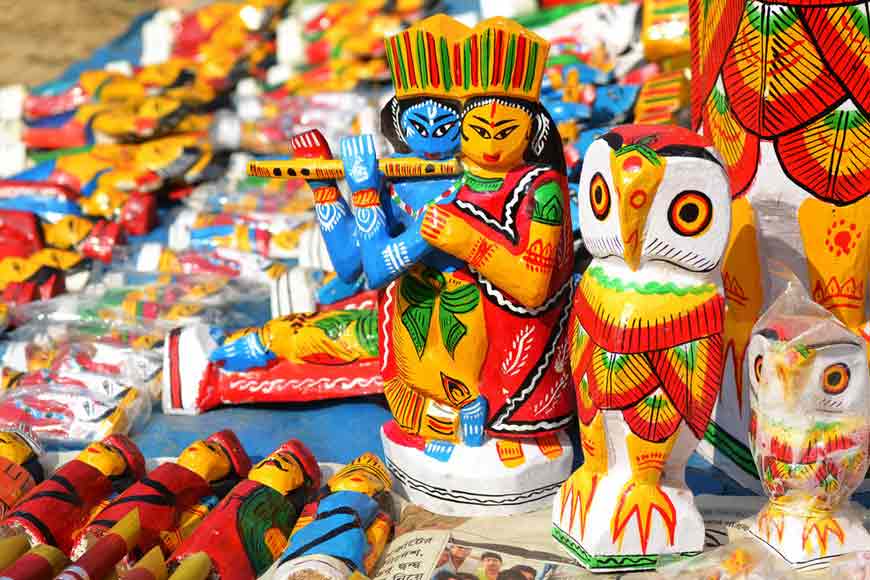
Rabindranath Tagore’s school Brahmacharyasrama started functioning formally from December 22, 1901 and that was a significant year. That year, 7 Poush was a memorable period for the first batch of Ashramites. The day was filled with full-throated melodious renditions and synchronized dance by Bauls (mystic minstrels) who roamed the fair ground with their quintessential ‘Ektara’ (an indigenous string musical instrument). There were myriad other forms of amusement at the fair including carousel rides, horse-racing track for the enthusiastic ones, mini circus, sellers hawking palm leaf hats and fans, masks, sweetmeat shops selling ‘monda’ (a type of sweet delicacy), crispy fried fritters, impromptu dance and music performances by groups of Santhali dancers, Jatra pala (a form of rural theatre) and whatnot. At dusk, people would scurry to join the evening prayer meet at Kanch Mandir. Rabindranath’s baritone voice would often rise above the din of the fair, as he recited the hymns of the Upanishads, “Yo Deva hagnou mantra.”
In the evenings, pupils would flock to Ratan Kuthi ground to watch fireworks display. The fireworks manufacturers would vie with each other to put up a spectacular show. The intense competitive spirit between the rivals would be palpable and often the spectators would be sucked into the playful spirit of competitiveness.
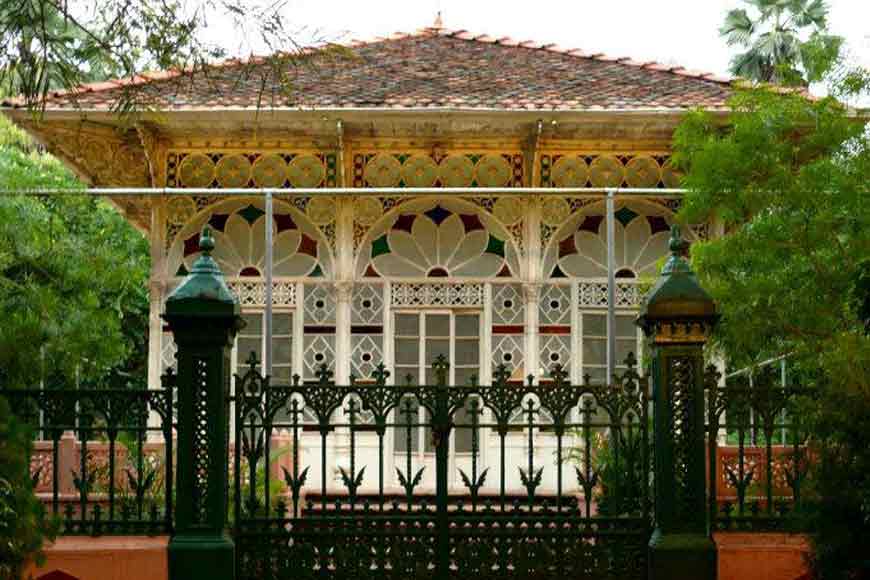
The Upasana Griha would be decorated aesthetically with fresh flowers and the melodious strains of Hara-Gouri Ragni would permeate the air. Jatra-gaan would start in the afternoon and late nights were reserved for the fireworks display. The next day, that is 8th Poush, was reserved for performances by ex-students of the ashram. On the final day of the festival on Poush 9, a special memorial service would be held to pay tribute to all the students, teachers, officials or anyone associated with the ashram, past or present, who had left for their heavenly abode.
Throughout his life, Rabindranath Tagore was not only involved in organizing the fair but he also endeavoured to make the event successful and worked to broaden its ambit. There were occasions when his call of duty forced him to stay abroad during the Poush Mela but he was always there in spirit. Once he was in Santiniketan but could not visit the fair ground due to ill health. He was full of remorse for his inability to visit the venue. Tagore’s demise, the Great Bengal Famine, the anguish of Partition – all these crucial events had impacted the fair. Poush Mela was revived in 1947 and since then, it has been an annual event at Santiniketan.
Time goes on at its own pace and every year, Bhuvandanga gets all set to host the most coveted event in the calendar, yes, the Poush Mela. As the veil of fog lifts slowly and the first soft rays of the sun fall on the freezing surface of the earth, the fair ground reverberates with the melodious renditions of Bauls and Keertaniyas (artistes who sing religious songs). The shopkeepers get busy arranging their merchandise. Maharshi Debendranath, a learned sage and reformer of the 19th century, who was way ahead of his times had a dream and the Poush Mela is the fulfillment of his vision where people from all over the world reconnect harmoniously.











